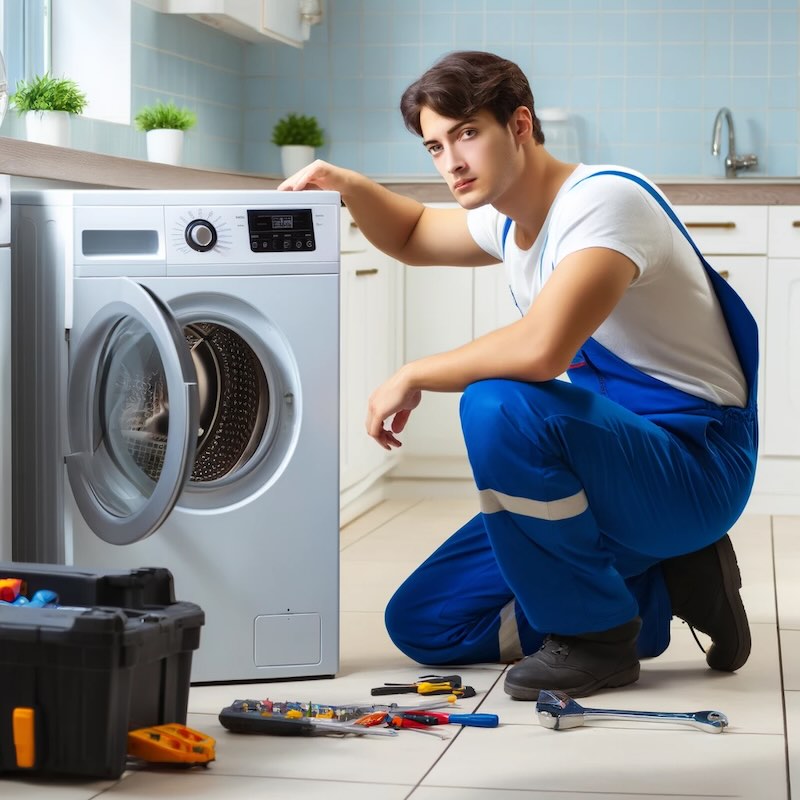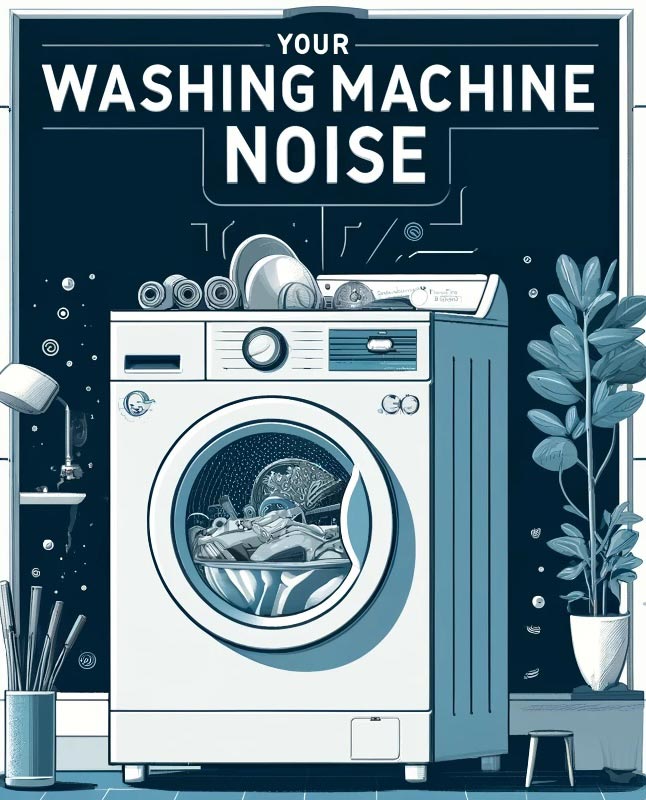
15 Apr How Do You Stop a Noisy Washing Machine?
The rhythmic hum of a washing machine spinning can be a comforting sound, a lullaby of clean clothes on the horizon. But what happens when that familiar hum morphs into a jarring rumble, a persistent banging, or a symphony of clangs? Suddenly, laundry day transforms from a routine chore into a frustrating battle against an appliance seemingly possessed by a mischievous goblin.
If you’re a laundry warrior, this guide is for you. This will equip you to decipher the cryptic language of your washing machine’s noises and identify the culprit behind the racket.
But first, let’s get into the inner workings of your machine, explore the potential causes of disruptive sounds, and offer solutions to restore quiet to your laundry routine.
Unveiling Inside Your Washing Machine
Before diagnosing any problem, let’s gain a deeper understanding of the instruments that make up your washing machine’s components. Each part plays a vital role in cleaning and spinning:
- Drum – a stainless-steel cylinder is the heart of the machine, where your clothes get tossed and tumbled by the swirling water.
- Water Inlet Valve – controls the water flow into the drum, ensuring the perfect amount for each cycle.
- Agitator (or Impeller) – a paddle-like component that stirs the clothes in the water, ensuring thorough cleaning. In some modern machines, an impeller replaces the agitator for a more gentle tumbling action.
- Water Pump – circulates the water within the drum, ensuring efficient cleaning and rinsing.
- Drainpipe – Think of this as the washing machine’s waste disposal. It whisks away dirty water after each wash cycle.
- Timer – This electronic mastermind controls the washing process, ensuring each cycle adheres to the programmed settings.
- Motor – This powerhouse provides the energy required for the drum to spin and the pump to circulate water.
- Drive System – consisting of a belt or a direct drive connection, transmits power from the motor to the drum, enabling it to spin.
- Shock Absorbers – act as buffers for the washing machine, dampening vibrations during the spin cycle and ensuring a smooth operation.
- Suspension Springs or Straps – support the tub, keeping it stable and preventing excessive shaking during the spin cycle.
With a basic understanding of the washing machine’s parts, let’s delve into what can disrupt their smooth operation and cause those unwanted noises.
Common Culprits of Washing Machine Noise
Noise emanating from your washing machine can be categorized into different types, each pointing towards a potential culprit. Here are some of the most common culprits behind the racket:
- Grinding Noise: This sound, often described as low-pitched grinding or rumbling, can indicate a problem with the tub bearings. These bearings are the tiny workhorses that allow the drum to spin smoothly on its axis. Over time, they can wear out due to wear and tear, leading to friction and grinding noise.
- Gurgling or Whining Noise: If your washing machine emits a gurgling sound or a high-pitched whining noise during the drain cycle, the culprit could be a clogged filter or pump. These components are responsible for trapping debris and filtering out dirty water. A clog hinders water flow, causing unusual noises and potentially hindering the machine’s ability to drain properly.
- Banging or Thumping Noise: This disruptive sound, often occurring during the spin cycle, can be caused by an unbalanced load. If your clothes are unevenly distributed within the drum, it can cause the machine to wobble and bang as it attempts to spin at high speeds. Imagine a washing machine as a spinning top – an uneven weight distribution throws everything off balance.
- Knocking or Clattering Noise: A rogue coin, button, or other small object lodged between the drum and the tub can create a persistent knocking or clanging sound during the spin cycle. These unwelcome guests disrupt the smooth rotation of the drum, causing it to bang against the surrounding components.
- Squealing or Clunking Noise: This noise can originate from a problem with the drive system. In machines with a belt drive system, a worn drive belt can cause a high-pitched squealing noise as it slips on the pulley. A faulty drive pulley might also be responsible for a clunking sound during the spin cycle. Think of a worn fan belt in your car – it makes a similar unpleasant sound.
- Loud Vibrations: If your washing machine vibrates excessively during the spin cycle, it could be caused by several factors:
- Uneven load: As mentioned earlier, an unbalanced load is a frequent culprit for vibrations. Redistribute the clothes in the drum for a more even weight distribution.
- Improper leveling: If your washing machine isn’t level on the floor, it can wobble and vibrate excessively during the spin cycle. Use an adjustable wrench to adjust the leveling feet until the machine sits perfectly stable.
- Worn shock absorbers or suspension components dampen vibrations and keep the machine stable. Over time, they can wear out and lose effectiveness, leading to excessive shaking.

Silencing the Noise
While the specific solution depends on the type of noise your washing machine is producing, here’s a breakdown of how to tackle some of the most common culprits:
Grinding Noise (Worn Tub Bearings): Unfortunately, replacing worn tub bearings is a complex repair and is best left to a qualified appliance technician. Don’t attempt a DIY fix, as improper installation can lead to further problems.
Gurgling or Whining Noise (Clogged Filter or Pump): Locate your washing machine’s filter (usually a small panel near the bottom front) and consult your user manual for cleaning instructions. For a clogged pump, you might need to access it by removing the back panel (consult your manual or call a technician if needed). Once accessible, carefully remove any debris blocking the pump.
Banging or Thumping Noise (Unbalanced Load): Stop the washing machine and redistribute the clothes in the drum for more even weight distribution. Aim for a mixture of large and small items to fill the space efficiently.
Knocking or Clattering Noise (Foreign Object): Stop and unplug the washing machine for safety. Check the rubber door seal and the space between the drum and the tub for any rogue coins, buttons, or other small objects causing the noise.
Squealing or Clunking Noise (Drive System Issues): A worn drive belt can often be replaced as a DIY project (consult your manual and safety instructions). However, for a faulty drive pulley or other drive system problems, it’s best to call a qualified appliance technician for proper diagnosis and repair.
Loud Vibrations: Ensure the washing machine is level using an adjustable wrench on the leveling feet. If the problem persists, it could indicate worn shock absorbers or suspension components, requiring a technician’s expertise.
Remember, if you’re unsure about any part of the troubleshooting process, don’t hesitate to consult your user manual or call a qualified appliance technician. By addressing these common noise culprits, you can keep your washing machine’s orchestra playing harmoniously and ensure peaceful laundry days.
Final Thoughts
This guide has equipped you with the knowledge to decipher the cryptic language of your washing machine’s noises. You’ve explored the inner workings of the machine, learned about the common culprits behind disruptive sounds, and discovered preventative measures to keep your laundry routine peaceful.
Remember, even the most robust washing machines require occasional care. By adopting a proactive approach, you can extend the life of your appliance and ensure years of quiet, efficient operation.
So, the next time your washing machine throws a noisy tantrum, don’t despair! With this knowledge, you can become a laundry-savvy detective, diagnose the problem, and restore peace to your laundry room.
If your washing machine requires a significant repair, don’t attempt a DIY Noisy Washing Machine fix. Instead, reach out to a qualified appliance repair technician to restore its functionality.
Frequently Asked Questions
Q: My washing machine is making a new noise, but it seems to work fine. Should I be worried?
A: Not necessarily. Sometimes, a new washing machine might slightly squeak during the first few cycles. This is usually normal and disappears as the parts break in. However, if the noise is persistent, loud, or unusual, consult your manufacturer’s manual or a qualified technician.
Q: How can I prevent my washing machine from making noise?
A: Here are some preventative measures you can take:
- Regular cleaning
- Balanced loads
- Check for loose objects
- Schedule maintenance
Q: I can’t identify the source of the noise. What should I do?
A: If you cannot pinpoint the noise source or the solutions above don’t resolve the issue, it’s best to consult a qualified appliance repair technician. They can diagnose the problem and recommend the necessary repairs to restore your washing machine to its quiet, efficient operation.
Q: Is repairing a noisy washing machine always cheaper than buying a new one?
A: The decision to repair or replace depends on several factors, including the age and value of your machine, the severity of the noise problem, and the estimated repair cost. Generally, repairs are more cost-effective for newer machines with minor noise issues. However, replacing the appliance might be a more economical option for older machines with extensive damage.

No Comments